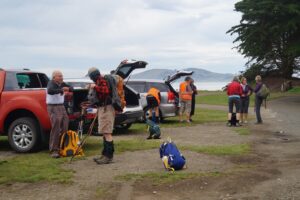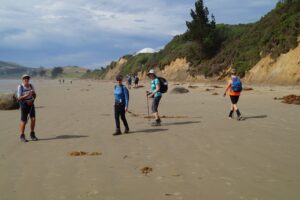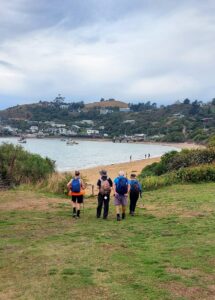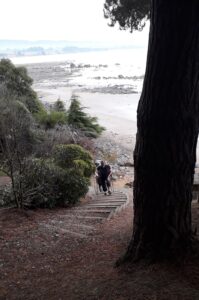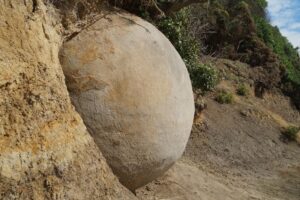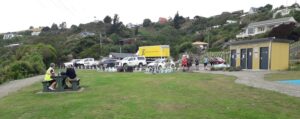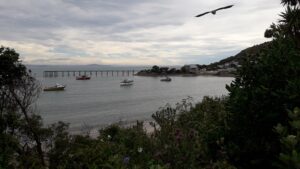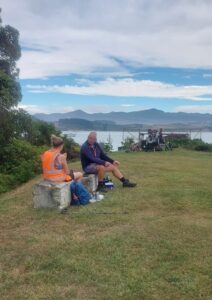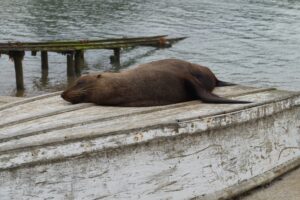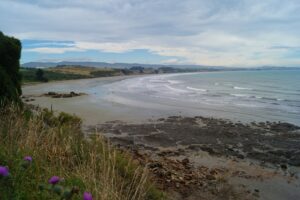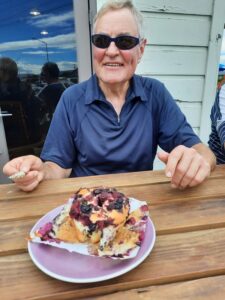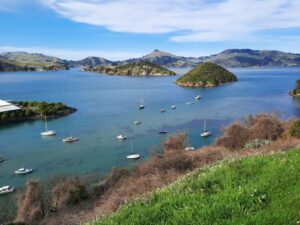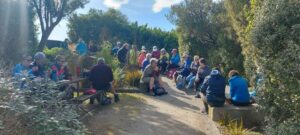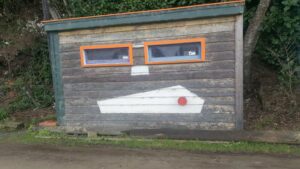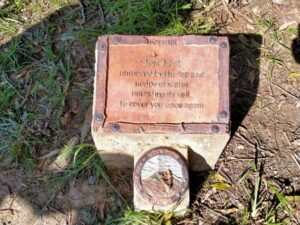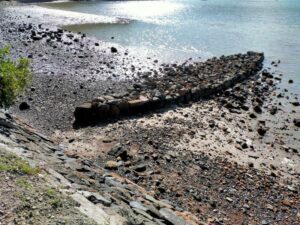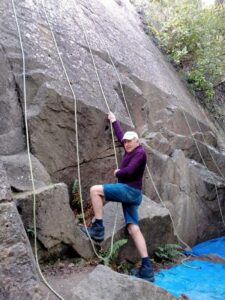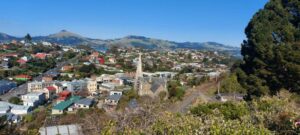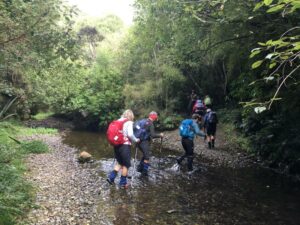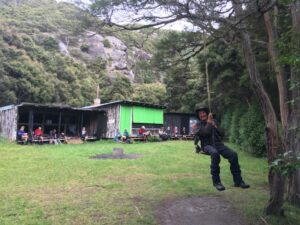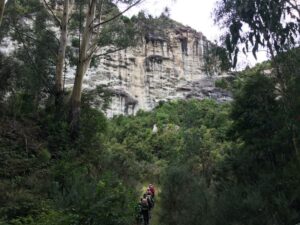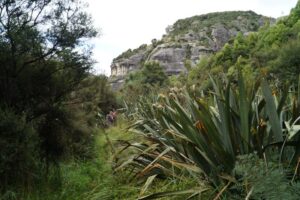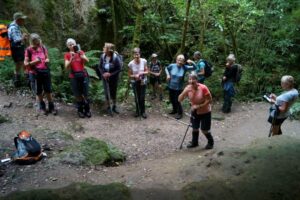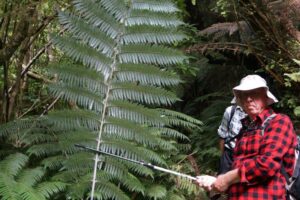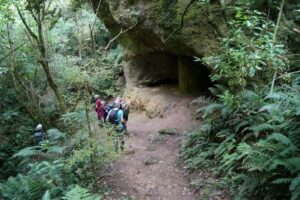Some History. (Can’t recall where I got it from. Sorry.)
Huriawa Peninsula. The peninsula was a superb natural pa site. Volcanic in origin, it rises sheer from the sea and had the twin blessings of a reliable spring and a small cove on its northern side where canoes could be safely beached. It was selected for this purpose in c. 1730 to serve Ngai Tahu under Te Wera, but had in all probability previously been used by Ngati Mamoe. It has excellent views to the north and south, and its natural defences of sea and cliffs is ideally suited for use as a pa.
it was originally call Pa-Katata, a name which is now used only for the rocky knob at the seaward point.
Te Wera had only just been chosen as chief by his Te Ruahikihiki hapu when they became embroiled in continual strife with his belligerent cousins, Taoka and Moki II. Trouble began when Te Wera was accused of practising makutu (wizardry) on his kinsfolk and of killing them. First he sought sanctuary at Purakaunui where Te Rehu, his brother-in-law held sway. Attacked there, the pair made a miraculous escape and arrived at Huriawa to find that a tangi for them had already begun. Together they exacted vengeance and in turn Taoka arrived at Huriawa and proceeded to lay siege. Taoka came by sea and set up camp on the sandspit, Olunepouwera, opposite the peninsula at the mouth of the Waikouaiti river. For six months the siege continued, as the pa had its own water supply, a large store of food including preserved birds, fern root and dried fish, and fishing parties could put out at night to supplement food stored on the well-nigh impregnable promontory. An anxious moment came when one of Taoka’s scouts crept in by way of the blow holes and stole the image of Te Wera’s protecting deity. Despair swept through the pa when Taoka was seen across the river saving it triumphantly above his head. But Te Wera’s tohunga Hautu restored it to the pa, some say simply through the air, by means of a powerful karakia. Finally Taoka was forced to withdraw for want of food as the defenders had denuded the area of vegetables before his taua (war party) arrived. The pa was then abandoned, and its inhabitants settled on the banks of the Waikouaiti river.
Later, Taoka turned his attention to Mapoutahi pa to telling effect. Te Wera eventually left the area altogether and moved south ultimately to die as an old man at Stewart Island.
The most prominent reminder of the history of the peninsula is the extensive terracing on its slopes. The terraces were made to provide level house sites and living and working areas. Remains of defensive banks and ditches can also be seen, though the actual palisade lines can be found only through the scientific techniques of archaeological excavation. In many places midden is exposed (shell, bone, charcoal and stone from cooking and other activities) can be seen in cliff edges, banks and slips. All cultural and historical material including archaeological sites, midden and artefacts are protected under the Historic Places Act 1980 and may not be interfered with in any way.
The blowholes on the peninsula are attributed to a romance. A couple eloped and eventually returned, expecting forgiveness. Instead, their irate families took them to the peninsula and hurled them from the cliffs. The young girl, heavier than her husband, is said to have caused the larger blowhole, that nearest Puketeraki Beach. There are in reality not two but three blowholes, but surviving mythology does not explain the third.
The reluctant missionary: A whaling station opened at Karitane in 1837 and it was here in 1840 rather than at which is now Waikouaiti that the Rev. James Watkin (1805-86) elected to live, despite the fact that he had come from Sydney at the instigation and at the expense of Johnny Jones. The Methodist missionary, who had been praying for a return to Britain, did not relish the experience; he chose for the text of the first Christian sermon preached in Otago, “This is a fearful saying”, and when his successor, the Rev. Charles Creed arrived in 1844 Watkin greeted him with words, “Welcome, Brother Creed, welcome to Purgatory.”
Certainly there was little for Watkin to enthuse over. The settlement was a hotbed of drunkenness, immorality and violence, from which the Maori mainly suffered, and the two-roomed native whare Jones provided for him was hardly suitable for one with a wife and five children. Certainly the nauseated Watkin tried, taking a firm stand against the vices of the Pakeha and the “savage customs” of the Maori. To a degree he succeeded; mission schools were established, converts made and an elementary Maori reader prepared and published. But Watkin was never reconciled to his position and was intensely relieved to sail for Wellington, leaving his degenerate parishioners behind. Tortured by ill health, he continually doubted his own considerable ability and lamented his lack of support and the depravity of those around him. A rare moment of elation came when one of his converts at Moeraki refused to give the census-taker Shortland any information because it was the Sabbath. Of Bishop Selwyn he conceded: “I think he is a good man, as far as his church prejudices will allow.”
Sir Truby King (1857-1938): In later years the settlement blossomed as a seaside resort and owes its geographical form partly to Sir Truby King, who had no sooner built his home on the peninsula than he became fearful that the river might cut through the slender isthmus that ties it to the mainland. He would not hesitate to rouse residents on stormy nights and direct them as they slaved to carry sand and build up the manuka sand-breaks he had placed on the narrow neck. Eventually the breaks were built up to such a degree that the danger passed. King was also the moving force behind the planting of various gums and hardy deciduous trees.
King is perhaps the best known of New Zealand’s medical reformers. Son of one of the first settlers at New Plymouth, he attended university at Glasgow and returned to become Superintendent, first of Wellington Hospital and then of the Seacliff Mental Hospital. A reformer in many fields he is best remembered for his founding of the Plunket Society (named after Lord Plunket, then Governor-General) which in his lifetime saw infant mortality drop by two-thirds, from 88.8 to 30.9 per 1,000 births. It was at his Karitane home that the first Plunket baby was reared. The Royal New Zealand Society for the Health of Women and Children (to give it its full title) remains an integral part not only of the country’s public health services, with Plunket Rooms throughout New Zealand staffed with Plunket nurses trained to educate mothers in child care, but of New Zealand society itself. Its success led to an invitation to King to establish a similar organisation in Britain. On his return in 1921 he became the first Director of Child Welfare and then, until his retirement in 1927 , Inspector-General of Mental Hospitals. Karitane nurses, trained in baby care, help mothers with their children.
The phenomenal success of the Plunket Society and the worldwide acclamation that followed have overshadowed other important aspects of his work. Truby King made major contributions in many fields – nutrition, plant acclimatisation, control of coastal erosion, alcoholism, psychological medicine and medical jurisprudence. His many achievements in the field of psychiatric medicine include dietary innovations, the establishment at Seacliff in 1898 of the country’s first “open” ward, the early development of the villa-hospital concept, and a study of the influence of dental disease on the physical and mental well-being of psychiatric patients. Change was not easily brought about and Truby King was frequently the centre of controversy, but invariably the soundness of his forcefully expressed views prevailed.
